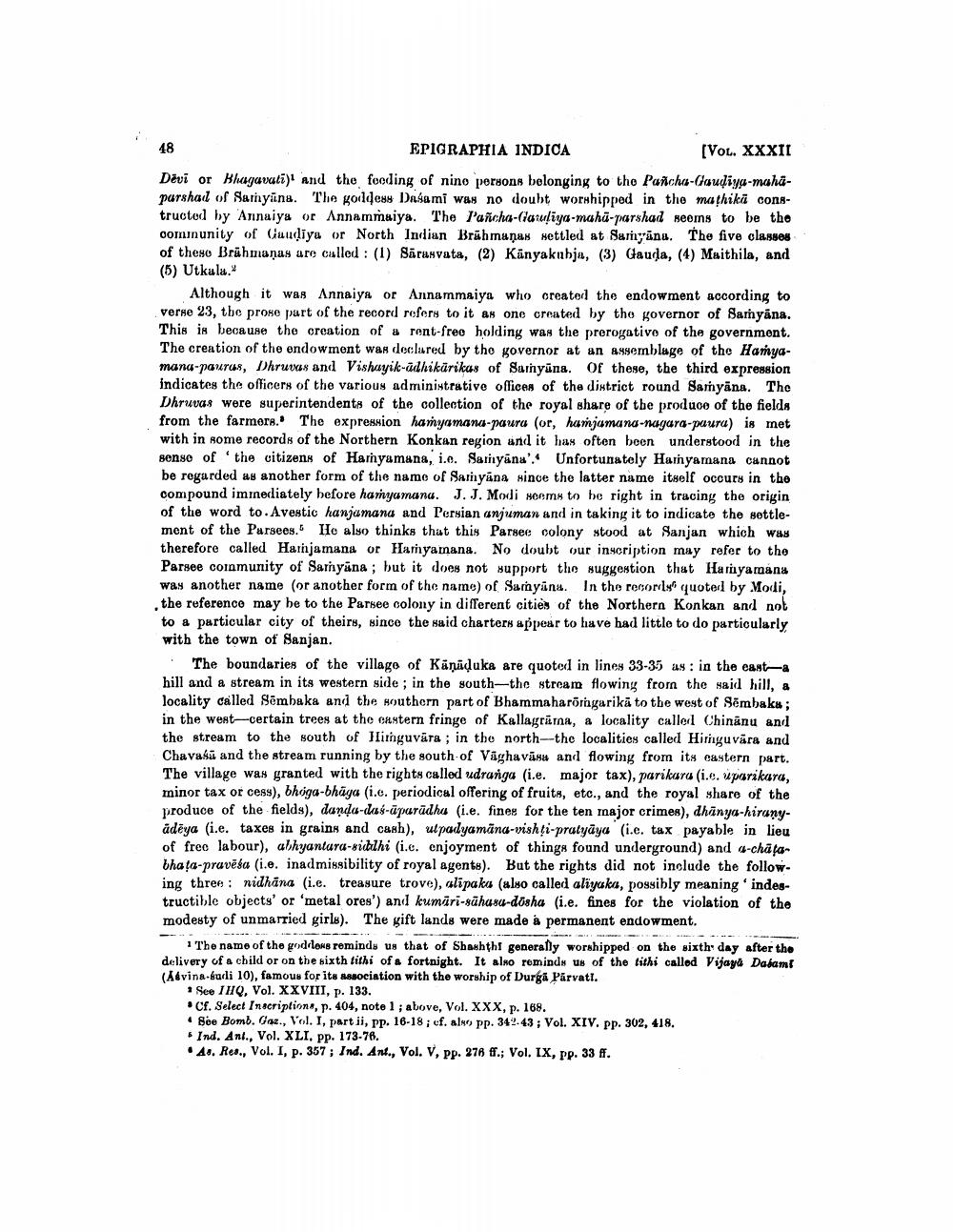________________
EPIGRAPHIA INDICA
[Vol. XXXII
Dövi or Bhagavati) and the fooding of nino persons belonging to the Pancha-Claudiya-mahapurshad of Suryana. The goddess Dasami was no doubt worshipped in the mathikä сonstructed by Annaiys or Annammuiya. The Pancha-Giaruliya-maha-parshad neems to be the community of Caudiya or North Indian Brāhmaṇas settled at Sariyanu. The five classes of theso Brühmaņas are called : (1) Sarasvata, (2) Kanyakubja, (3) Gauda, (4) Maithila, and (5) Utkula.
Although it was Annaiya or Annammaiya who created the endowment according to verse 23, the proso part of the record refers to it as one created by the governor of Saryana. This is because the creation of a rent-free holding was the prerogativo of the government. The creation of the endowment was declared by the governor at an assemblage of the Hanyamana-paurus, Dhruvas and Vishayik-adhikūrikas of Saryana. Of these, the third expression indicates the officers of the various administrative offices of the district round Samyana. The Dhruvas were superintendents of the collection of the royal share of the produce of the fields from the farmers. The expression hanyamana-paura (or, hamjamana-nagara-puura) is met with in some records of the Northern Konkan region and it has often boon understood in the sense of the citizens of Haryamana, i.e. Sariyana'. Unfortunately Haryamana cannot be regarded as another form of the name of Sariyana since the latter name itself occurs in the compound immediately before hanyamana. J.J. Modi Heems to be right in tracing the origin of the word to. Avestic hanjumana and Persian anjuman and in taking it to indicate the settlement of the Parsees. Ho also thinks that this Parsee colony stood at Sanjan which was therefore called Hathjamana or Haryamana. No doubt our inscription may refer to the Parsee coinmunity of Saryana; but it does not support the suggestion that Haryamana was another name (or another form of the name) of Samyans. In the recorrly quoted by Modi, , the reference may be to the Parsee colony in different cities of the Northern Konkan and not
to a particular city of theirs, since the said charters appear to have had little to do particularly with the town of Sanjan.
The boundaries of the village of Käņāduka are quoted in lines 33-35 us: in the easthill and a stream in its western side; in the south-the stream flowing from the said hill, a locality called Sombaka and the southern part of Bhammaharörngarika to the west of Sombaka; in the west-certain trees at the eastern fringe of Kallagrára, a locality calle Chinanu and the stream to the south of Himguvāra ; in the north--the localities called Hiriguvära and Chavasi and the stream running by the south of Vaghavāsa and flowing from its eastern part.
The village was granted with the rights called udranga (i.e. major tax), parikara (i.e. uparikara, minor tax or cess), bhoga-bhāga (i.e. periodical offering of fruits, etc., and the royal share of the produce of the fields), danda-das-ūparādha (i.e. fines for the ten major crimes), dhanya-hiranyadėya (i.e. taxes in grains and cash), utpadyamana-vishți-pratyāya (i.e. tax payable in lieu of free labour), abhyantara-richlhi (i.e. enjoyment of things found underground) and a-châtabhaça-pravēša (i.e. inadmissibility of royal agents). But the rights did not include the following three : nidhāna (i.e. treasure trove), alīpaka (also called aliyaka, possibly meaning indestructible objects' or 'metal ores') and kumari-sahasa-dosha (i.e. fines for the violation of the modesty of unmarried girls). The gift lands were made a permanent endowment.
The name of the good loss reminds us that of Shashthi generally worshipped on the sixth day after the delivery of a child or on the sixth tithi of a fortnight. It also reminds us of the tithi called Vijaya Dalam Alvina budi 10), famous for its association with the worship of Durga Parvati.
See HQ, Vol. XXVIII, p. 133. Cf. Select Inscriptions, p. 404, note 1; above, Vol. XXX, p. 168. • Boo Bomb. Co., Vol. I, partii, pp. 16-18; cf. also pp. 342.43 ; Vol. XIV. pp. 302, 418. - Ind. Ant., Vol. XLI. pp. 173-76. . 46. Res., Vol. I, p. 357; Ind. Ant., Vol. V, pp. 276 ff.; Vol. IX, PP. 33 ff.




